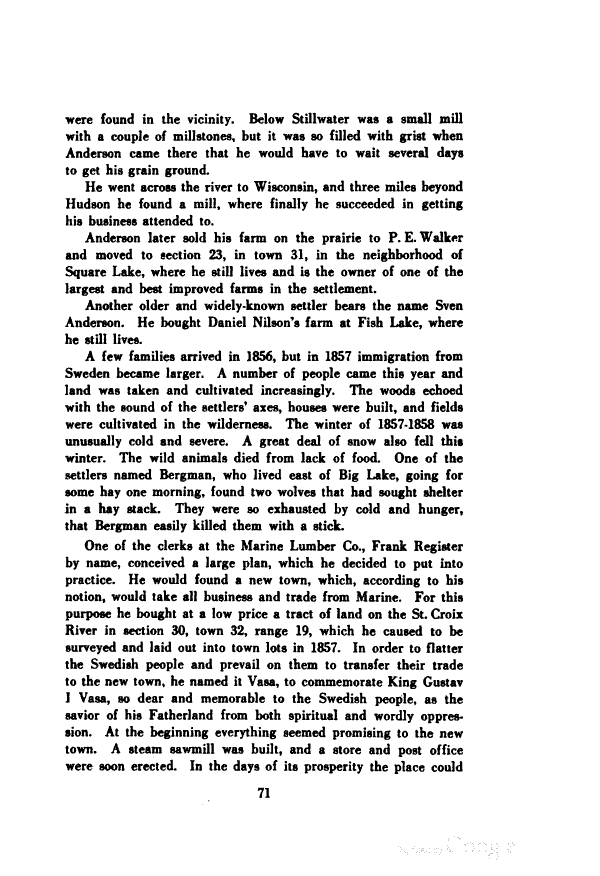
Full resolution (TIFF) - On this page / på denna sida - Sidor ...

<< prev. page << föreg. sida << >> nästa sida >> next page >>
Below is the raw OCR text
from the above scanned image.
Do you see an error? Proofread the page now!
Här nedan syns maskintolkade texten från faksimilbilden ovan.
Ser du något fel? Korrekturläs sidan nu!
This page has been proofread at least once.
(diff)
(history)
Denna sida har korrekturlästs minst en gång.
(skillnad)
(historik)
were found in the vicinity. Below Stillwater was a small mill
with a couple of millstones, but it was so filled with grist when
Anderson came there that he would have to wait several days
to get his grain ground.
He went across the river to Wisconsin, and three miles beyond
Hudson he found a mill, where finally he succeeded in getting
his business attended to.
Anderson later sold his farm on the prairie to P. E. Walker
and moved to section 23, in town 31, in the neighborhood of
Square Lake, where he still lives and is the owner of one of the
largest and best improved farms in the settlement.
Another older and widely-known settler bears the name Sven
Anderson. He bought Daniel Nilson’s farm at Fish Lake, where
he still lives.
A few families arrived in 1856, but in 1857 immigration from
Sweden became larger. A number of people came this year and
land was taken and cultivated increasingly. The woods echoed
with the sound of the settlers’ axes, houses were built, and fields
were cultivated in the wilderness. The winter of 1857-1858 was
unusually cold and severe. A great deal of snow also fell this
winter. The wild animals died from lack of food. One of the
settlers named Bergman, who lived east of Big Lake, going for
some hay one morning, found two wolves that had sought shelter
in a hay stack. They were so exhausted by cold and hunger,
that Bergman easily killed them with a stick.
One of the clerks at the Marine Lumber Co., Frank Register
by name, conceived a large plan, which he decided to put into
practice. He would found a new town, which, according to his
notion, would take all business and trade from Marine. For this
purpose he bought at a low price a tract of land on the St. Croix
River in section 30, town 32, range 19, which he caused to be
surveyed and laid out into town lots in 1857. In order to flatter
the Swedish people and prevail on them to transfer their trade
to the new town, he named it Vasa, to commemorate King Gustav
I Vasa, so dear and memorable to the Swedish people, as the
savior of his Fatherland from both spiritual and wordly
oppression. At the beginning everything seemed promising to the new
town. A steam sawmill was built, and a store and post office
were soon erected. In the days of its prosperity the place could
<< prev. page << föreg. sida << >> nästa sida >> next page >>